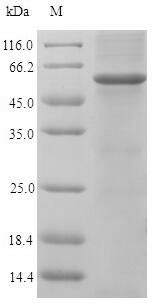Recombinant Chicken Homeobox protein engrailed-1 (EN1) is produced using an E.coli expression system and contains the full-length protein sequence from 1-333 amino acids. The protein carries an N-terminal 6xHis-B2M tag for purification and detection. SDS-PAGE analysis confirms greater than 90% purity, which makes it suitable for various research applications.
Homeobox protein engrailed-1 (EN1) appears to play a vital role in developmental processes and pattern formation. Research suggests it regulates gene expression during embryonic development, with particular effects on neural and skeletal structures. Given its critical function in these pathways, EN1 has become a significant focus of research in developmental biology and related fields.
Potential Applications
Note: The applications listed below are based on what we know about this protein's biological functions, published research, and experience from experts in the field. However, we haven't fully tested all of these applications ourselves yet. We'd recommend running some preliminary tests first to make sure they work for your specific research goals.
The chicken EN1 is a homeobox transcription factor that requires correct folding of its DNA-binding domain (homeodomain) and potential dimerization for biological activity. While the B2M tag may improve solubility and folding in E. coli, prokaryotic systems lack chaperones and post-translational modifications needed for optimal folding of eukaryotic transcription factors. The high purity suggests minimal impurities, but it does not guarantee native conformation. Without experimental validation (e.g., circular dichroism for secondary structure or DNA-binding assays), the protein may be misfolded or inactive. Therefore, correct folding and bioactivity cannot be assumed and must be verified before functional applications.
1. Protein-Protein Interaction Studies
If the recombinant EN1 protein is verified to be correctly folded (e.g., through biophysical assays), it could be used in pull-down assays to study interactions with partners from tissue lysates. The His-B2M tag facilitates immobilization, but misfolding may alter binding sites or cause non-specific interactions. Results should be validated with native EN1 from eukaryotic sources to ensure physiological relevance.
2. DNA-Protein Binding Assays
Provided that the protein is confirmed to have functional DNA-binding activity (e.g., via EMSA or SPR controls), it can be used to study binding specificity and kinetics. The full-length construct includes the homeodomain, but misfolding could impair DNA recognition. Preliminary validation with known engrailed binding sequences is essential to avoid false negatives/positives.
3. Antibody Development and Validation
This recombinant EN1 is suitable as an immunogen for antibody production, as antibodies often recognize linear epitopes even in misfolded proteins. The high purity supports immunization protocols. However, antibodies generated may not bind native EN1 in physiological contexts (e.g., in chromatin). Validation against eukaryotic-expressed EN1 is critical for applications like immunofluorescence or Western blot.
4. Structural and Biophysical Characterization
The protein is appropriate for biophysical analyses (e.g., circular dichroism to assess secondary structure, dynamic light scattering to check aggregation) to evaluate folding status. However, correct folding is required for high-resolution structural studies (e.g., crystallography). A misfolded protein may yield misleading data. These assays can themselves serve as validation tools before functional use.
5. In Vitro Transcription Assays
This application requires a fully functional EN1 with DNA-binding and transcriptional regulatory activity. If bioactivity is confirmed (e.g., through complementation assays), the protein could be added to cell-free systems to study transcription. However, without validation, misfolded EN1 may fail to regulate transcription, leading to inaccurate conclusions. Pre-testing in a reconstituted system is necessary.
Final Recommendation & Action Plan
Before using this recombinant EN1 protein for any functional study, prioritize experimental validation of its folding and bioactivity. Start with biophysical assays (e.g., circular dichroism to confirm expected α-helical content in the homeodomain, size-exclusion chromatography to monitor oligomerization) to assess folding. Then, perform functional tests such as EMSA with a known EN1-binding DNA sequence to verify DNA-binding capability. If activity is confirmed, proceed with interaction or transcription assays; otherwise, limit use to non-functional applications like antibody production, but always validate outcomes with native protein.






